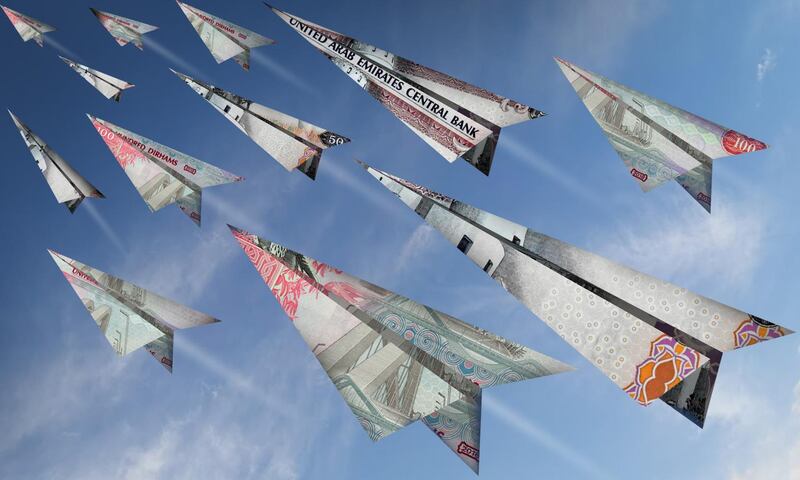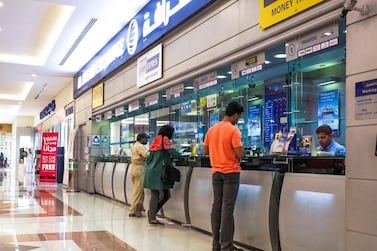With a host of different ways to send your hard-earned dirhams overseas, the money transfer industry in the UAE is ruthlessly competitive.
There's a reason for that though: the UAE is one of the largest outbound remitter countries in the world, with around Dh39.9 billion sent to home countries by residents in the fourth quarter of 2018, according to recent data from the Central Bank of the UAE.
It also boasts some of the busiest remittance corridors with Indians sending 34.2 per cent of total remittances in that period followed by Pakistan and the Philippines.
While a competitive industry helps drive down prices, new technology is also making remittances faster and more convenient. But if you want the best price, you must compare the options, as there can be hidden charges, high upfront fees and large spreads on currency exchange rates.
“It pays to do your research before you pick a transfer service,” says Ambareen Musa, founder and chief executive of financial comparison site Souqalmal.com. “You must carefully compare exchange rates, transfer fees and processing times to make an informed choice.” So, which is the best option?
Exchange houses
Exchanges houses are the most popular way to send money home from the UAE, accounting for nearly three quarters of all remittance transactions, according to the Central Bank. Dh30.4bn in remittances were transferred through exchange houses in the fourth quarter of 2018, compared to the Dh9.5bn wired from banks.
Those hunting for the best deal can compare prices on the World Bank portal, which analyses remittance corridors to low -and -middle-income countries, including India, Pakistan and the Philippines.
Designed to compare prices when sending relatively small amounts of money – around Dh700 and Dh1800 dirhams, some of the lowest cost exchange houses on the UAE to India corridor it cites are Al Fardan Exchange, GCC Exchange, Al Ansari, Wall St Exchange, Western Union, and Emirates NBD’s DirectRemit offered by a bank.
While customers can choose between different transfer services – including bank-to-bank, cash-to-cash and even transfers to mobile wallets - the best deal is normally to be found on account-to-account transfers, rather than cash. At Al Rostamani Exchange, sending from one bank account to another gets a significantly better rate than from cash to cash, according to a company representative.
GCC Exchange, which consistently ranks as one of the cheapest exchange houses on the World Bank’s list, only allows online bank transfers to a handful of beneficiary countries, with other countries requiring cash deposits in a branch. However, both cash and online transfers receive the same rate, and the difference in fee is small, according to a company representative.
Transfer costs also change regularly, so if you’ve been using one service for a while review other options again.
Last year, for example, Western Union reduced some of its prices across the Middle East in response to market competition, a decision that helped boost its transaction volumes. Data from the World Bank finds that a Dh1,835 transfer from the UAE to India via Western Union in early 2016 had an upfront fee of Dh20 dirhams and a 2 per cent margin on the exchange rate; by the end of 2018 the same transfer had an upfront fee of Dh15 and a margin of 0.93 per cent.
“In the UAE we are very well aligned with the market [on price], this is something we do on a continuous basis. We do our market research, and then we align our prices accordingly,” says Hatem Sleiman, Western Union’s regional vice president for the Middle East, Pakistan & Afghanistan.
Mr Sleiman notes the prevalence of hidden charges in the industry. “Most money transfer operators advertise Dh20 [as the regular fee] to send money, but the receiver doesn’t receive the full amount, there are hidden charges here and there. It’s a marketing game. At Western Union we have a clear visibility around prices – if you send 1,000 dirhams you will receive 1,000 dirhams in the local currency.”
Banks
International transfers through your bank can be fast and convenient – but it can also be a more expensive options with higher margins and transaction fees. In recent years, however, some UAE banks have rolled out products to compete with exchange houses.
According to the World Bank, the cheapest way to fund a remittance transaction globally in the fourth quarter of last year was mobile money at 4.9 per cent. The average cost when using a debit or credit card was 6.13 per cent. Sending money using cash cost 7.012 per cent, while funding the transaction using a bank account incurred an average cost of 7.11 per cent.
Emirates NBD launched its DirectRemit product in 2014, which can be used to send money to banks in key remittance countries including India, Pakistan, Philippines in as little as 60 seconds, with the service extended to the UK last year.
DirectRemit has no transaction fee and offers “competitive exchange rates” says Suvo Sarkar, the head of retail banking and wealth management at Emirates NBD. The service will be extended to cover “all major global currencies and remittance markets in the future" he adds.
Mashreq Bank began offering Quick Remit last year, covering India and Pakistan, with new markets to be launched soon. Transfers can be completed between banks in as little as 60 seconds.
Rohit Garg, head of business banking at Mashreq Bank, says historically exchange houses were the most popular option for sending money abroad, while banks were “basically fringe players”.
“That’s changed in the past two-three years, when innovation started coming in; you could send money instantly, you could send money on your mobile,” says Mr Garg.
Swift growth of bank accounts in key markets like India and Pakistan is another factor making bank to bank transfers more popular, he says.
QuickRemit has no transaction fee, while the exchange rate margin is competitive, Mr Garg adds. “We, the banks are the challengers,” he says.
If you plan to make regular transfers home, signing up with an international bank that has branches in your home country can have advantages, says Steve Cronin, founder of the online financial community DeadSimpleSaving.com. He advocates having accounts "with at least two different banks in the UAE, in case you encounter unexpected problems with your main bank".
Haggle or join a club
When sending money from an exchange house, it is always wise to try and haggle down to the best possible rate. If you’re transferring a large chunk of cash, or if a company expects you to be a regular customer, then you might be able to negotiate a better rate or a fee waiver.
While priority or corporate banking customers are often offered better rates than standard customers, exchange houses also offer benefits to priority customers. UAE Exchange has Club Exclusive, a loyalty programme that offers benefits including competitive rates, a dedicated relationship manager, a doorstep service and priority treatment so you can avoid waiting in branch queues. There’s no hard and fast rule on who can be admitted to the club – eligibility is mainly around designation, and expected transfers should be at least Dh367,000 per year, though there are no annual minimum transfer amounts or membership fees, according to a representative.
One satisfied customer is Fred Wobus, 44, a systems engineer who lives in Abu Dhabi. He uses the scheme to transfer money home to the UK, and says with the Dh52.50 fee combined with a “slight spread” on the UAE exchange, the total cost he pays can be as low as 0.45 per cent of the amount he’s transferring, when it’s a large amount like Dh40,000. For amounts less than Dh10,000dh, the total cost is around 0.9 per cent he says.
Online platforms
Another option is international platforms such as Currency Fair or Moneycorp, which are able to receive dirhams in their overseas bank accounts – transferring dirhams can be cheaper than a regular international transfer – while these platforms also promise more attractive margins than banks.
This option can be more complicated and slower than a regular bank or exchange house transfer and you must ensure your bank transfers dirhams to the overseas account, rather than automatically exchanging your transfer to the local currency. A bigger stumbling block though is that some UAE banks refuse to send dirhams overseas, says Mr Cronin.
Some platforms like Moneycorp lock in the exchange rate when you schedule a transfer, useful if you want to take advantage of an attractive rate. But if you don’t complete the transaction you may be charged the costs of buying the currency in advance, if it moves in the other direction.
Currency Fair, however, does not lock in the rate, meaning it could change by the time your money arrives; on the other hand, if you don’t complete the transaction you won’t incur a charge.
Currency Fair also has an optional peer-to-peer exchange platform, where you can post your desired exchange rate, and wait to be matched with another customer who wants to make the reverse trade. This will likely be a slightly slower process, but it may allow you to achieve a better rate than is available with an exchange house or bank.
When to send?
Last year was a great time for sending money from the UAE for many workers, with the dollar-pegged dirham riding high against currencies such as the Indian rupee and British pound.
Given that no one can predict future rates, if currency is moving favourably for you, a smart strategy is to send money when a rate reaches a new milestone, says Sudhesh Giriyan, the chief operating officer of Xpress Money.
“For example when the Indian rupee crossed 20 against the dirham last year, it was a great opportunity for Indian expats to make use of the rate and send money back home. It will be very difficult to hang on for another few weeks and hope you will get a better rate.”
If you’re planning to send a large amount home and aren’t in any hurry, it can be wise to break it up into multiple transfers across several weeks or months, to avoid the risk of sending money at a time when the currency is in a short-term dip, Mr Giriyan advises. “Over two to three instalments you would have averaged out the rate at which you send the money back,” he adds.
However, Ms Musa advises that bundling up your funds into a large single transfer can result in lower transaction costs. Regular remitters should keep track of the movement in exchange rates, she says. “This will help you time your transfer more strategically, especially if you can hold off on your remittance and transfer in bulk when the exchange rate is most favourable.”








